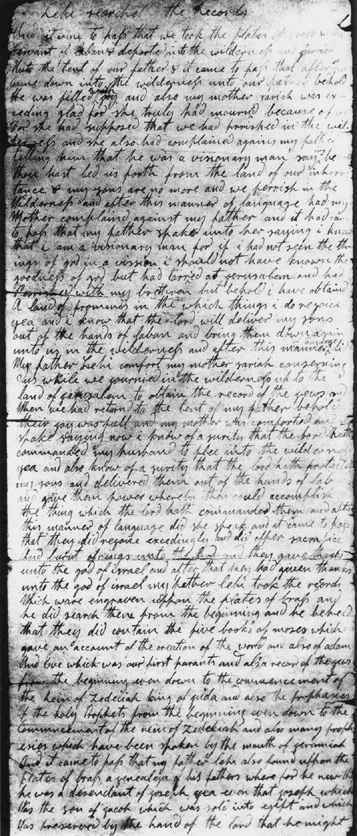 "Day after day I continued, uninterrupted, to write from his mouth…a voice dictated by the inspiration of heaven."
"Day after day I continued, uninterrupted, to write from his mouth…a voice dictated by the inspiration of heaven."-Oliver Cowdery
About 1,400 years after Moroni buried the golden plates, Joseph Smith uncovered them at the hill Cumora and on Sept. 22, 1827. After he retrieved the plates, he began the process of translation. Through the course of the translation Joseph used four different scribes who wrote as he translated aloud (Encyclopedia of Mormonism).
Royal Skousen, a leading scholar on the Book of Mormon, wrote an article entitled, "Book of Mormon Editions" in which he chronologically follows the emergence of the B
 ook of Mormon.
ook of Mormon.- 1830: 5,000 published in Palmyra, New York. Minor grammatical changes, no versification.
- 1840: 2,000 editions published in Nauvoo, Illinois. Joseph Smith compared the printed text with the original manuscript and discovered a number of errors made in copying the printer's manuscript from the original. Thus the 1840 edition restores some of the readings of the original manuscript.
- 1852: Editor Franklin Richards added numbers to the paragraphs to aid in finding passages.
- 1879: Edited by Orson Pratt. Major changes in the format of the text included division of the long chapters in the original text, a true versification system (which has been followed in all subsequent LDS editions), and footnotes.
- 1920: Edited by James E. Talmage. Further changes in format included introductory material, double columns, chapter summaries, and new footnotes.
- 1981: Edited by a committee headed by members of the Quorum of the Twelve. This edition is a major reworking of the 1920 edition: The text appears again in double columns, but new introductory material, chapter summaries, and footnotes are provided.
I read 1 Nep 2 as we read it today. Chopped up into verses. My mind went into "scripture mode" (similar to "sleep mode" J/K!) and I read. As I was reading it from a literary standpoint, I noticed how certain verses belonged in the same "paragraph" and where a natural end to a paragraph would be. Then came the 1830 facsimile of the Book of Mormon and boom-bam-baby, my reading experienced a complete 180! Reading it as a novel, I saw the story, more than the highlighted verse. There was flow. I read emotion into it, something lost to me in the chopped-up version published today.
Example: 1Nep 2:19-24. 6 verses in the current format, 1 paragraph in the 1830 edition. Type that section, then read it. The difference for me: The Lord's "voice" stays current through the entire passage. I "hear" Him speaking through the entire passage, something lost to me when I read it in chunks. The running text directly ascribes the dialogue to the Lord.
I love how you were able to read the 1830 version of the Book of Mormon. One thing I think is important to note is that although the Book of Mormon went through different editions, it has never changed text wise or had several different adaptations as the Bible has undergone. I think today we're blessed to have the Book of Mormon in a versified form to make for an easier read. It is easy to keep track of what we are reading chapter by chapter. But I do agree with you that at times our brains get in to scripture mode and we lose some of the beauty of it as being told as a story.
ReplyDeleteI wonder if you were to teach a Sunday School lesson and used the 1830 version if a deeper conversation and new understanding would be brought to the classroom.